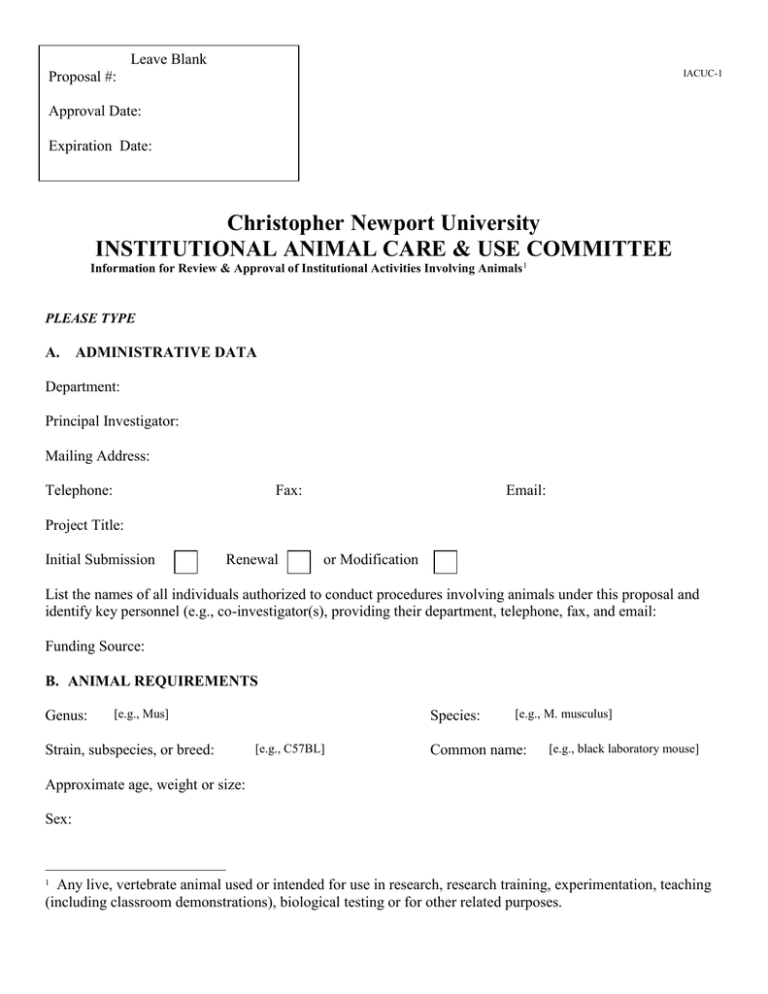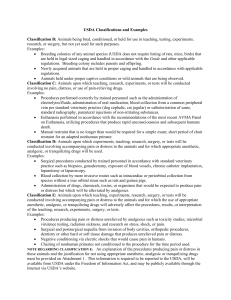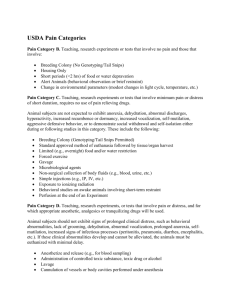Christopher Newport University INSTITUTIONAL ANIMAL CARE & USE COMMITTEE
advertisement

Leave Blank IACUC-1 Proposal #: Approval Date: Expiration Date: P R O P Christopher Newport University O S CARE & USE COMMITTEE INSTITUTIONAL ANIMAL Information for Review & Approval of InstitutionalAActivities Involving Animals 1 L # : PLEASE TYPE A. ADMINISTRATIVE DATA A P P R O V A L Department: Principal Investigator: Mailing Address: Telephone: Fax: Email: D A T Initial Submission Renewal or Modification E : List the names ofDATE: all individuals authorized to conduct procedures involving animals under this proposal and EXPIRATION identify key personnel (e.g., co-investigator(s), providing their department, telephone, fax, and email: P Funding Source: P B. ANIMAL REQUIREMENTS O S [e.g., Mus] [e.g., M. musculus] Genus: Species: A L [e.g., C57BL] Strain, subspecies, or breed: Common name: [e.g., black laboratory mouse] # Approximate age, weight or size: : R Sex: O P O S 1 Any live, vertebrate animal used or intended for useAin research, research training, experimentation, teaching (including classroom demonstrations), biological testing L or for other related purposes. Project Title: # : CNU IACUC-1 Bacteriological status: 2 [e.g., germfree (axenic), defined flora (gnotobiotic), specific pathogen free, conventional] [e.g., simian immunodeficency virus, simian retrovirus] Viral status: B. ANIMAL REQUIREMENTS CONTINUED [e.g., name of vendor or breeder, bred in-house] Source(s): Primary housing location(s): Have advance arrangements been made for the housing and care of the animals? Yes No Will the animals be housed and maintained on campus? Yes No Location(s) where manipulation will be conducted: Number of Animals to be Used: Year 1: Total: Year 2: Year 3: C. TRANSPORTATION Will animals be transported after having been secured for CNU use? Yes No If yes, how? NOTE: Transportation of animals must conform to all institutional guidelines/policies and federal regulations. If animals will be transported on public roads or out of state, describe efforts to comply with USDA regulations. If animals will be transported between facilities, describe the methods and containment to be utilized. If animals will be transported within a facility, include the route and elevator(s) to be utilized. D. STUDY OBJECTIVES (Insert text here.) Briefly explain in language understandable to a layperson the aim of the study and why the study is important to human or animal health, the advancement of knowledge, or the good of society. [NOTE: This section must be completed in such a manner that outside reviewers and interested publics can fully understand the project parameters, procedures, and designs. Investigators are advised to seek outside assistance when appropriate for completing this section.] E. RATIONALE FOR ANIMAL USE (Insert text here.) 1) Explain your rationale for animal use. [The rationale should include reasons why non-animal models cannot be used.] 2) Justify the appropriateness of the species selected. [The species selected should be the lowest possible on the phylogenetic scale.] 3) Justify the number of animals to be used. [The number of animals should be the minimum number required to obtain statistically valid results.] CNU IACUC-1 3 F. DESCRIPTION OF EXPERIMENTAL DESIGN AND ANIMAL PROCEDURES (Insert text here.) Briefly explain the experimental design and specify all animal procedures. This description should allow the IACUC to understand the experimental course of an animal from its entry into the experiment to the endpoint of the study. Specifically address the following: Experimental injections or inoculations (substances, e.g., infectious agents, adjuvants, etc.; dose, sites, volume, route, and schedules). Blood withdrawals (volume, frequency, withdrawal sites, and methodology). Surgical procedures (provide details of survival and non-survival surgical procedures in Section G.). Radiation (dosage and schedule). Methods of restraint (e.g., restraint chairs, collars, vests, harnesses, slings, etc.). Include how animals are restrained for routine procedures like blood withdrawals. Prolonged restraint must be justified with appropriate oversight to ensure it is minimally distressing. Describe any sedation, acclimation or training to be utilized. Animal identification methods (e.g., ear tags, tattoos, collar, cage card, implant, etc.). Other procedures (e.g., survival studies, tail biopsies, etc.). Resultant effects, if any, that the animals are expected to experience (e.g., pain or distress, ascites production, etc.). Other potential stressors (e.g., food or water deprivation, noxious stimuli, environmental stress) and procedures to monitor and minimize distress. If a study is USDA Classification E, indicate any nonpharmaceutical methods to minimize pain and distress. Experimental endpoint criteria (e.g., tumor size, percentage body weight gain or loss, inability to eat or drink, behavioral abnormalities, clinical symptomatology, or signs of toxicity) must be specified when the administration of tumor cells, biologics, infectious agents, radiation or toxic chemicals are expected to cause significant symptomatology or are potentially lethal. List the criteria to be used to determine when euthanasia is to be performed. Death as an endpoint must always be scientifically justified. Veterinary care (indicate desired plan of action in case of animal illness, e.g., initiate treatment, call investigator prior to initiating treatment, euthanize). G. SURGERY: Yes No If surgery is proposed, complete the following: (Insert text here.) 1. Identify and describe the surgical procedure(s) to be performed. Include preoperative procedures (e.g., fasting, analgesic loading), and monitoring and supportive care during surgery. Include the aseptic methods to be utilized. 2. Who will perform surgery and what are their qualifications and/or experience? 3. Where will surgery be performed and postoperative care provided (building and rooms)? 4. If survival surgery, describe postoperative care required, frequency of observation, and identify the responsible individual(s). Include detection and management of postoperative complications during work hours, after hours, weekends and holidays. 5. If non-survival surgery, describe how humane euthanasia is enacted and how death is determined. CNU IACUC-1 4 6. Are paralytic agents used during surgery? If yes, please describe how ventilation will be maintained and how pain will be assessed. 7. Has major survival surgery been performed on any animal prior to being placed on this study? [Major survival surgery penetrates and exposes a body cavity or produces substantial impairment of physical or physiologic functions (such as laparotomy, thoracotomy, crainotomy, joint replacement, or limb amputation).] If yes, please explain: 8. Will more than one major survival surgery be performed on an animal while on this study? If yes, please justify: H. PAIN OR DISTRESS CLASSIFICATION AND CONSIDERATION OF ALTERNATIVES 1. Pain or Distress Classification Species (common name) USDA Classification* B, C, D or E Number of animals used each year Year 1 Year 2 3 year total number of animals Year 3 Total number of animals (should equal total from Section B): * USDA Classifications and Examples Classification B: Animals being bred, conditioned, or held for use in teaching, testing, experiments, research, or surgery, but not yet used for such purposes. Examples: Breeding colonies of any animal species (USDA does not require listing of rats, mice, birds) that are held in legal sized caging and handled in accordance with the Guide and other applicable regulations. Breeding colony includes parents and offspring. Newly acquired animals that are held in proper caging and handled in accordance with applicable regulations. Animals held under proper captive conditions or wild animals that are being observed. Classification C: Animals upon which teaching, research, experiments, or tests will be conducted involving no pain, distress, or use of pain-relieving drugs. Examples: CNU IACUC-1 5 Procedures performed correctly by trained personnel such as the administration of electrolytes/fluids, administration of oral medication, blood collection from a common peripheral vein per standard veterinary practice (dog cephalic, cat jugular) or catheterization of same, standard radiography, parenteral injections of non-irritating substances. Euthanasia performed in accordance with the recommendations of the most recent AVMA Panel on Euthanasia, utilizing procedures that produce rapid unconsciousness and subsequent humane death. Manual restraint that is no longer than would be required for a simple exam; short period of chair restraint for an adapted nonhuman primate. Classification D: Animals upon which experiments, teaching, research, surgery, or tests will be conducted involving accompanying pain or distress to the animals and for which appropriate anesthetic, analgesic, or tranquilizing drugs will be used. Examples: Surgical procedures conducted by trained personnel in accordance with standard veterinary practice such as biopsies, gonadectomy, exposure of blood vessels, chronic catheter implantation, laparotomy or laparoscopy. Blood collection by more invasive routes such as intracardiac or periorbital collection from species without a true orbital sinus such as rats and guinea pigs. Administration of drugs, chemicals, toxins, or organisms that would be expected to produce pain or distress but which will be alleviated by analgesics. Classification E: Animals upon which teaching, experiments, research, surgery, or tests will be conducted involving accompanying pain or distress to the animals and for which the use of appropriate anesthetic, analgesic, or tranquilizing drugs will adversely affect the procedures, results, or interpretation of the teaching, research, experiments, surgery, or tests. Examples: Procedures producing pain or distress unrelieved by analgesics such as toxicity studies, microbial virulence testing, radiation sickness, and research on stress, shock, or pain. Surgical and postsurgical sequella from invasion of body cavities, orthopedic procedures, dentistry or other hard or soft tissue damage that produces unrelieved pain or distress. Negative conditioning via electric shocks that would cause pain in humans. Chairing of nonhuman primates not conditioned to the procedure for the time period used. An explanation of the procedures producing pain or distress in these animals and the justification for not using appropriate anesthetic, analgesic or tranquilizing drugs must be provided on Attachment 1. This information is required to be reported to the USDA, will be available from USDA under the Freedom of Information Act, and may be publicly available through the Internet via USDA’s website. NOTE REGARDING CLASSIFICATION E: 2. Consideration of Alternatives If any procedures fall into USDA's Classification D or E, causing more than momentary or slight pain or distress to the animals, describe your consideration of alternatives and your determination that alternatives are not available. Delineate the methods and sources used in the search. Database references must include databases searched, the date of the search, period covered, and the keywords used. Alternatives include methods that (1) refine existing tests by minimizing animal distress, (2) reduce the number of animals necessary for an experiment, or (3) replace whole-animal use with in vitro or other tests. When ascites production is used to produce antibodies, justification needs to be given as to why in vitro systems cannot be used. Note that you CNU IACUC-1 6 must certify in Section Q.5. that no valid alternative was identified to any described procedures which may cause more than momentary pain or distress, whether relieved or not. Yes No I. ANESTHESIA, ANALGESIA, TRANQUILIZATION, OTHER AGENTS: For animals indicated in Section H.1., Classification D, specify the anesthetics, analgesics, sedatives or tranquilizers that are to be used. Include the name of the agent(s), the dosage, route and schedule of administration. If information is provided in Section G. above, please cross-reference. Describe tracking and security of controlled drugs (Drug Enforcement Agency requirements). J. METHOD OF EUTHANASIA OR DISPOSITION OF ANIMALS AT END OF STUDY Indicate the proposed method of euthanasia. If a chemical agent is used specify the dosage and route of administration. If the method(s) of euthanasia include those not recommended by the AVMA Panel Report on Euthanasia (e.g., decapitation or cervical dislocation without anesthesia), provide scientific justification why such methods must be used. Indicate the method of carcass disposal if not described in Section K. below. K. HAZARDOUS AGENTS Yes No Use of hazardous agents requires the approval of the appropriate safety official. Attach documentation of approval for the use of recombinant DNA or potential human pathogens, and supply the following information: Hazardous Agent Radionuclides Biological Agents Hazardous Chemicals or Drugs Recombinant DNA Agent Date of Biosafety Approval Tracking # Study Conducted at Animal Biosafety Level: 1 2 3 4 Describe the practices and procedures required for the safe handling and disposal of contaminated animals and material associated with this study. Also describe methods for removal of radioactive waste and, if applicable, the monitoring of radioactivity. Additional safety considerations: L. BIOLOGICAL MATERIAL/ANIMAL PRODUCTS FOR USE IN ANIMALS (e.g., cell lines, antiserum, etc.) 1. Specify Material: 2. Source: Material Sterile or Attenuated: Yes No If derived from rodents, has the material been MAP/RAP/HAP tested? [MAP - Mouse Antibody Production; RAP Rat Antibody Production; HAP - Hamster Antibody Production] Yes 3. (Attach copy of results) or No I certify that the MAP/RAP/HAP tested materials to be used have not been passed through rodent species outside of the animal facility in question and/or the material is derived from the original MAP tested sample. To the best of my knowledge the material remains uncontaminated with rodent pathogens. Initials of Principal Investigator. CNU IACUC-1 7 M. TRANSGENIC AND KNOCKOUT ANIMALS Yes No If yes, describe any phenotypic consequences of the genetic manipulations to the animals. Describe any special care or monitoring that the animals will require. N. EXEMPTIONS FROM ENVIRONMENTAL ENHANCEMENT FOR NONHUMAN PRIMATES OR EXERCISE FOR DOGS Christopher Newport University does not have the facilities for the housing and maintenance of non-human primates. Research activity involving these animals housed at other institutions can be approved by the IACUC. 1. For nonhuman primates, are you seeking an exemption for scientific reasons from the institution’s plan for environment enhancement? Yes or No If yes, provide the basis of the request. 2. For dogs, are you seeking an exemption for scientific reasons from the institution’s plan to provide dogs with the opportunity for exercise? Yes or No If yes, provide the basis of the request. [NOTE: Dogs that are pets are NOT to be used in any institutional use without prior approval of IACUC. This use includes teaching demonstrations and other related activities. Christopher Newport University does not have the facilities necessary for the housing and care of Canine species. Dogs may be used for teaching or demonstration purposes, but only with prior approval of the activity.] O. FIELD STUDIES Yes No If animals in the wild will be used, describe how they will be observed, any interactions with the animals, whether the animals will be disturbed or affected, and any special procedures anticipated. Indicate if Federal permits are required and whether they have been obtained. 1. 2. 3. 4. Animals will be: captured observed in natural habitat marked for identification Animals will be: euthanized released shortly after capture held in captivity See section XVI on permits for the use of wildlife. Section O should include discussion of capture devices, restraint devices, surgical procedures, etc., if the activity will involve these procedures. P. SOCIAL ENRICHMENT Will the animals used need social enrichment? Yes_____ No______ If yes, please describe your plan for the animals’ social enrichment. If no, please explain why the animals will not require social enrichment. CNU IACUC-1 8 Q. TRAINING Briefly describe the training, workshops, and certifications that qualify the primary investigator of this protocol. If there are any students involved in this protocol, please describe the training they have/will receive before participating in this protocol. (You are required to maintain documentation of all student training) R. SPECIAL CONCERNS OR REQUIREMENTS OF THE STUDY List any special housing, equipment, animal care (e.g., special caging, water, feed, or waste disposal, environmental enhancement, etc.). S. ASSURANCES 1. I hereby certify that the foregoing information is complete and correct and that professionally acceptable, ethical, and humane standards governing the care, treatment, and use of animals will be followed. 2. I assure that discomfort and injury to animals will be limited to that which is unavoidable in the conduct of scientifically valuable research, and that appropriate anesthetic, analgesic, and/or tranquilizing drugs will be used to relieve all unnecessary pain and distress for the subject animals during teaching, research, testing, and post-operative care. 3. I hereby certify that these studies do not unnecessarily duplicate previous experiments. 4. I assure that personnel conducting procedures on the animals being maintained or studied are appropriately qualified and trained in these procedures. 5. I assure that animals that would otherwise experience severe or chronic pain or distress that cannot be relieved will be painlessly euthanized at the end of procedures or, if appropriate, during the procedure. 6. I assure that alternatives to the use of animals have been explored, and that these alternatives are not appropriate for this research activity. 7. I certify that I am familiar with and will comply with all pertinent institutional, state, and federal rules and policies CNU IACUC-1 9 8. I agree to cooperate with the Christopher Newport University Institutional Animal Care and Use Committee in their supervision of these laws and policies. _________________________________ Principal Investigator _____________________________ _____________ Address Date APPROVAL I have reviewed this animal use protocol and recommend it for approval by the Institutional Animal Care and Use Commitee. _______________________________ IACUC Member ________________________ Unit _________________________________ IACUC Veterinarian __________________ Date _________________________________ Institutional Official ___________________ Date _____________ Date COMMENTS:_____________________________________________________________________________ __________________________________________________________________________________________ __________________________________________________________________________________________ ____________________________________________________________________ CNU IACUC-1 10 Attachment 1 Explanation for USDA Classification E (This report is required to accompany USDA Form 7023 to support any USDA Classification E listings.) This document must be typed. Name of investigator: Animal Study Proposal Title: Species and number of animals listed in Classification E for each year: Species: Number of animals: year 1 year 2 year 3 Total: Description of project including reason(s) for species selection: Provide a scientific justification to explain why the use of anesthetics, analgesics, sedatives or tranquilizers during and/or following painful or distressing procedures is contraindicated: Signature of investigator: Date: Signature of IACUC Chairperson: Date:

